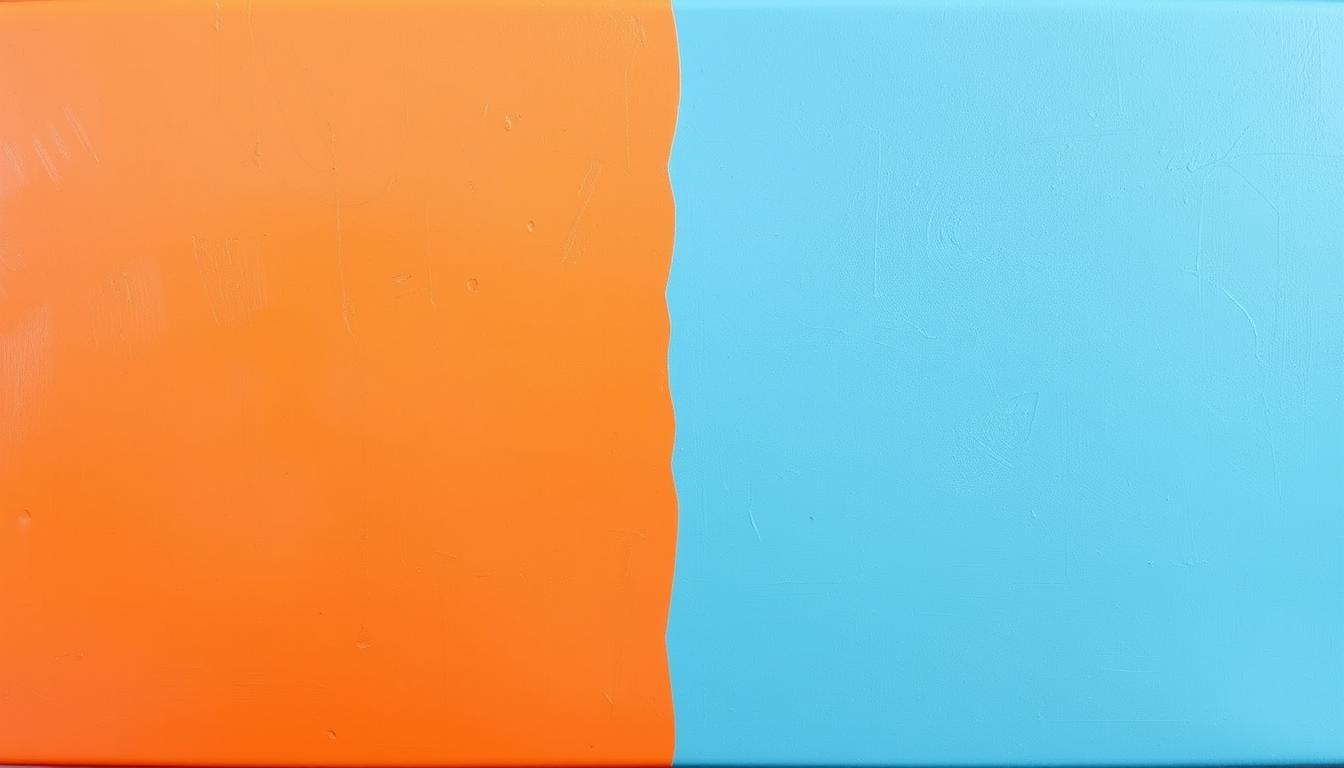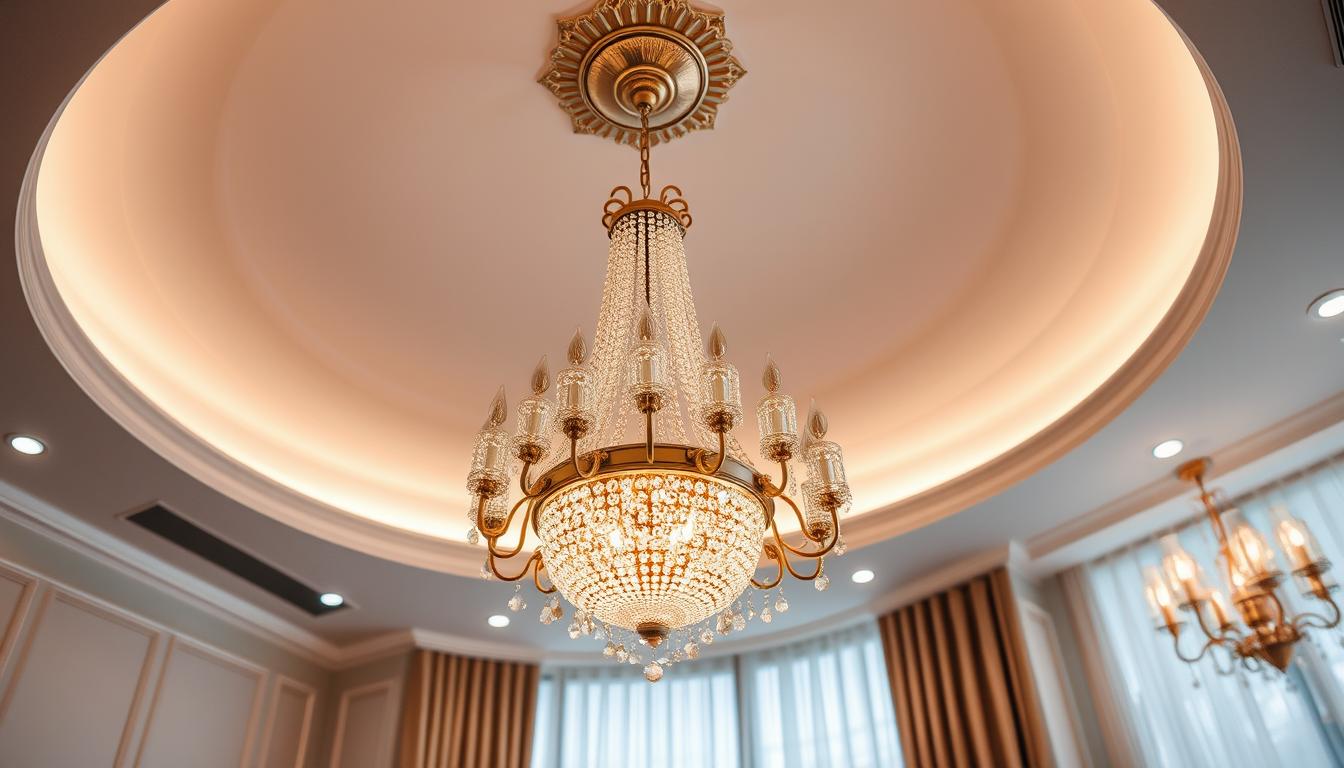Welcome to our comprehensive guide on paint sheen. Here, we’ll help you pick the right finish for every room in your home. With many sheen levels out there, choosing the perfect finish can seem daunting.
It’s vital to understand the various finish types and sheen levels. This knowledge is key to achieving the look and durability you desire in your space. In this article, we’ll dive into the different paint sheens. We’ll also offer practical tips and recommendations to help you make the best choice for your needs.
Our aim is to give you a deep understanding of finish types and sheen levels. This will empower you to make informed decisions for your painting projects. Whether you’re updating a single room or your entire home, we’ve got you covered.
Key Takeaways
- Choose the right finish types for each room to achieve the desired look and durability.
- Understand the different sheen levels and their characteristics.
- Consider factors such as room traffic, wall surface condition, and lighting when selecting a paint sheen.
- Finish types and sheen levels can greatly impact the overall appearance of your space.
- Practical tips and recommendations can help you make the best choice for your specific needs.
Understanding Paint Sheen and Its Importance
Choosing the right paint for your room involves considering durability factors closely. Paint sheen, or the level of gloss, is key. It impacts how your walls look and how easy they are to maintain. Room considerations, like natural light and foot traffic, also influence your choice.
High-gloss paint is durable and easy to clean but shows brush strokes and roller marks. Flat paint hides imperfections but isn’t as durable. Your specific needs will guide you to the best paint sheen.
- Flat (matte) paint: best for low-traffic areas and hiding imperfections
- Eggshell paint: suitable for moderate-traffic areas and provides a subtle sheen
- Satin paint: ideal for high-traffic areas and offers a soft, warm glow
- Semi-gloss paint: perfect for trim and moldings, and provides a high level of durability
By weighing durability factors and room considerations, you can choose the right paint sheen. This ensures your walls are both beautiful and durable, lasting through daily use.
Common Types of Paint Sheens
Choosing the right paint sheen is crucial. The sheen type significantly affects light reflection in a room. This makes it a key factor in your decision. Different sheens are better suited for various areas of the home, based on practical application.
There are several paint sheens to consider, including flat, eggshell, satin, and semi-gloss. Each has unique characteristics and uses. For instance, flat paint is great for ceilings and low-traffic areas because it conceals imperfections well and is simple to touch up. Semi-gloss paint, on the other hand, is durable and moisture-resistant. It’s often chosen for trim, doors, and windows.
Here are the main features of each paint sheen:
- Flat (matte) paint: hides imperfections, easy to touch up, suitable for low-traffic areas
- Eggshell paint: slightly higher sheen level than flat paint, often used on walls and trim
- Satin paint: medium sheen level, durable and easy to clean, suitable for high-traffic areas
- Semi-gloss paint: high sheen level, highly durable and resistant to moisture, often used on trim, doors, and windows
When choosing a paint sheen, consider its practical application. Think about light reflection and durability. This way, homeowners can make an informed choice. They can achieve the desired look and feel in their space.
Factors That Influence Paint Sheen Selection
Choosing the right paint sheen involves several key factors. The surface appearance of your walls is critical. The finish types you pick can significantly alter the look and feel of your space. Consider the room’s traffic and usage, as high-traffic areas need more durable paints with higher sheen levels.
A smooth wall surface is best for lower sheen levels. On the other hand, a rough surface may need a paint with a higher sheen level to conceal imperfections. The type and intensity of lighting also play a role. For example, a room with plenty of natural light can often handle a lower sheen level. In contrast, a room with limited lighting may require a higher sheen level to reflect available light.
Room Traffic and Usage
- High-traffic areas, such as hallways and entryways, require more durable paints with higher sheen levels
- Low-traffic areas, such as bedrooms, can handle lower sheen levels
Wall Surface Condition
The condition of your wall surface is crucial in determining the ideal paint sheen. A rough surface may need a paint with a higher sheen level to hide imperfections. On the other hand, a smooth surface can manage a lower sheen level.
Lighting Considerations
Lighting significantly impacts the appearance of your paint. It’s vital to consider the type and intensity of lighting in your room. Natural light, artificial light, and the direction of light sources all influence how your paint appears.
Kitchen and Bathroom Paint Sheen Guide
In kitchens and bathrooms, sheen levels are key to paint durability and maintenance. These spaces face moisture, grease, and food splatters. Thus, it’s vital to pick paint that can handle these challenges.
Considerations for these rooms include humidity levels, foot traffic, and lighting types. For instance, a kitchen with plenty of natural light might need a paint with a higher sheen level. This helps reflect light and brighten the area.
Here are some tips for selecting the right paint sheen for your kitchen and bathroom:
- In kitchens, opt for semi-gloss or high-gloss paint to resist grease and food splatters.
- For bathrooms, choose paint with a higher sheen level to combat moisture and humidity.
- Remember the specific room considerations, like foot traffic and lighting types.
By weighing these factors and picking the correct paint sheen, you can achieve a stunning, long-lasting space. It will meet your needs and endure over time.
| Room | Recommended Sheen Level |
|---|---|
| Kitchen | Semi-gloss or high-gloss |
| Bathroom | High-gloss |
Living Room and Bedroom Finish Options
In living rooms and bedrooms, the ambiance and aesthetics are key. The sheen level of the paint significantly influences the atmosphere, with higher sheens offering a more formal and elegant vibe. It’s important to consider durability factors like furniture wear and foot traffic. Also, light reflection greatly affects the room’s ambiance, with certain sheens enhancing or reducing light effects.
Choosing the right sheen can greatly impact the room’s feel. For a formal look, semi-gloss or high-gloss sheens work well. For a more casual vibe, eggshell or flat sheens are better. When selecting a sheen, consider several factors:
- Durability requirements: Assess the room’s wear and tear and pick a sheen that can handle it.
- Light reflection: Think about the room’s light levels and choose a sheen that complements or contrasts them.
- Color impact: Consider how the paint color will affect the room’s mood and atmosphere.
The right sheen for living rooms and bedrooms depends on personal taste and space needs. By weighing durability factors and light reflection, you can pick a sheen that enhances the room’s ambiance and atmosphere.
| Sheen Level | Description | Durability | Light Reflection |
|---|---|---|---|
| Flat | A low-sheen paint with a matte finish | Low | Minimized |
| Eggshell | A low-sheen paint with a slight gloss | Medium | Slightly accentuated |
| Semi-gloss | A high-sheen paint with a noticeable gloss | High | Accentuated |
Selecting the Perfect Paint Sheen for Trim and Moldings
When painting trim and moldings, a practical application is key for a lasting finish. The surface appearance of these areas significantly influences a room’s overall look. Choosing the right paint sheen is crucial for a professional finish.
Semi-gloss or high-gloss paints are ideal for trim and moldings due to their durability and ease of cleaning. Yet, each area’s specific needs must be considered. For instance, trim might need a higher sheen to resist scratches and scuffs. Moldings, on the other hand, may require a higher sheen to combat moisture and humidity.
When picking a paint sheen for trim and moldings, consider these factors:
- Durability: Opt for a high sheen to endure wear and tear.
- Cleanability: Semi-gloss or high-gloss paints are simple to clean and maintain.
- Maintenance: Select a paint that can handle the maintenance level of each area.
In conclusion, choosing the right paint sheen for trim and moldings demands a thoughtful approach. By considering the practical application and surface appearance of each area, you can achieve a professional finish. This finish will be both durable and easy to maintain.
| Paint Sheen | Characteristics | Recommended Use |
|---|---|---|
| Semi-Gloss | Durable, easy to clean | Trim, moldings, doors |
| High-Gloss | Highly durable, easy to clean | Trim, moldings, doors, high-traffic areas |
Ceiling Paint Sheen Recommendations
Choosing the right finish for ceiling paint is crucial for both appearance and durability. A flat or low-sheen finish is ideal for ceilings, as it reduces glare and reflections. This is vital in rooms with high ceilings or those bathed in natural light.
Flat paint is a top choice for ceilings, as it conceals imperfections and is simple to touch up. Yet, bathroom ceilings require special attention. Here, a paint with a higher sheen is needed to combat moisture and humidity.
Finish Types for Ceilings
Popular ceiling finishes include:
- Flat: A non-reflective finish that hides imperfections well and is easy to touch up.
- Matte: A low-sheen finish that is slightly more reflective than flat paint.
- Eggshell: A finish with a slight sheen that is easy to clean and resists scuffs.
The ideal ceiling finish depends on personal taste and room-specific needs. By examining sheen levels and finish types, you can select a paint that offers both beauty and durability.
Special Considerations for Bathroom Ceilings
Bathroom ceilings demand paint that can handle moisture and humidity. A semi-gloss or high-gloss finish is often necessary for a durable, water-resistant coat.
| Finish Type | Sheen Level | Durability |
|---|---|---|
| Flat | 0-10% | Low |
| Matte | 10-30% | Medium |
| Eggshell | 30-50% | High |
By understanding your ceiling’s needs and selecting the right finish and sheen, you can achieve a lasting, beautiful paint job.
High-Traffic Areas: Making Durable Choices
In high-traffic zones like hallways and entryways, room considerations are crucial for paint selection. These spots face constant wear and dirt, necessitating durable paint. Opting for semi-gloss or high-gloss paint is wise, as they resist moisture and are simple to clean.
Considering the look you desire is also vital. High-gloss paint can introduce elegance, while semi-gloss offers a more understated appearance. Your choice should align with your style and the home’s specific requirements.
- Moisture resistance
- Ease of cleaning
- Durability
- Aesthetics
By focusing on these aspects and choosing the right paint, you can create a space that’s both beautiful and practical. In areas like mudrooms and laundry rooms, room considerations such as moisture and humidity are critical. It’s essential to select paint that can handle these conditions.
| Area | Recommended Paint |
|---|---|
| Hallways and Entryways | Semi-gloss or High-gloss |
| Mudrooms and Laundry Areas | Semi-gloss or High-gloss |
Professional Tips for Paint Sheen Application
Applying paint sheen requires a smooth and even finish. To achieve this, start by cleaning and sanding the surface. This step ensures the paint adheres well, resulting in a practical application that lasts.
Using the right tools and equipment is also crucial. A high-quality brush or roller can significantly impact the final result. It’s important to consider the light reflection in the area. This can affect the paint’s appearance and the room’s ambiance.
Some key tips for applying paint sheen include:
- Using a primer to create a uniform base
- Applying thin coats to avoid drips and unevenness
- Allowing each coat to dry completely before applying the next one
By following these tips and considering the light reflection and practical application, you can achieve a professional-looking finish. This will enhance the beauty of your space.
Common Paint Sheen Mistakes to Avoid
Choosing the right paint sheen is crucial for the look of your walls. Many common mistakes can impact the finish and appearance. Knowing these errors and how to avoid them is key to a professional finish.
Mixing different sheens is a major mistake. It leads to an uneven finish and affects the paint’s appearance. This issue is more noticeable in areas with lots of natural light. The varying sheens can reflect light differently, altering the paint’s look.
Mixing Different Sheens
- Can create an uneven finish
- Affects the appearance of the paint
- Can be noticeable in areas with high levels of natural light
Choosing the wrong sheen for a room can also be a problem. For instance, a flat sheen might work for low-traffic areas but not for busy ones. In high-traffic spaces, a higher sheen is more durable and easier to clean. This maintains a better appearance and finish.
Inappropriate Room Selection
Applying paint too thickly or unevenly is another mistake. It can ruin the paint’s appearance and durability. Always follow the manufacturer’s instructions. Apply the paint smoothly and evenly for a professional finish and desired look.
Conclusion: Making Your Final Paint Sheen Decision
Choosing the right paint sheen levels for each room is key to achieving the perfect look and function. By considering factors like traffic, surface conditions, lighting, and maintenance needs, you can make a choice that boosts both beauty and practicality. This ensures your living spaces are enhanced.
Whether you’re updating a bedroom, refreshing a busy hallway, or turning a bathroom into a calm retreat, the correct paint sheen matters. It balances durability, light reflection, and visual appeal. This way, you can craft interiors that are not only harmonious but also reflect your personal style.
It’s important to note that there’s no universal paint sheen for all rooms. Each space has its own needs. By understanding these differences, you can transform your environment into something inspiring and delightful. Let paint be your canvas, and bring your vision to life, room by room.






